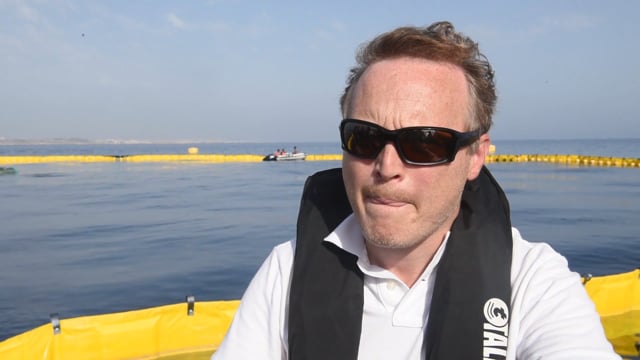[WATCH] Fish farms not sole sea slime source, says tuna industry
Dealing with the fish farm slime problem has involved a learning curve, aquaculture federation secretary John Refalo said, but more is now being done to prevent leakage into the sea


People’s complaints regarding slime seeping into swimming areas are justified, but it has to be acknowledged that fish farms are not the only source of the foul-smelling liquid, Federation of Maltese Aquaculture Producers John Refalo has said.
Refalo was speaking during a tour for the press of the northeast and southeast aquaculture zones, located 5km off Malta’s shores, where five operators, four of which are members of the federation, own several tuna fish farms containing hundreds of the fish, which can weigh upwards of 120kg.
After travelling to the two fish farm zones - a 20 minute trip from Manoel Island to the northeast zone on the fast dinghy we were on, but one which takes upwards of two hours on the boats used to give the fish their daily feed of sardines and mackerel - journalists were shown how tuna ranchers have deployed a system of booms, skimmers and other equipment to prevent slime from leaking into the open sea.
Following a strong expression of public disapproval to the appearance of malodorous slime - the source of which is deemed to be the food given to the farmed tuna - in a number of popular swimming areas around Malta, the fish ranchers have invested in additional booms to keep the offending liquid isolated from the open waters, Refalo said.


Preparations for the feeding process start in the early hours of morning, every day, with the sardines and mackerel, packed into sacks, being loaded on boats which depart from Marsaxlokk or the Grand Harbour. Once at the tuna pens, cranes on the boats lower the fish into the tuna feeding cages.
When the fish are thrown into the sea, they release oils, which make the water murky - the booms, however, are meant to prevent the oils from leaving the enclosed pen area. The oil collected within the boom is then collected using special equipment on the boats, and ultimately exported to Italy and Greece, where it is refined and used for other purposes. Skimmers are also used to collect oil which hasn’t remained contained within the booms, with a one thousand litre skimmer typically filling itself up by the end of the day.
Despite these efforts, incidents still happen, and Refalo concedes that the booms alone have not completely solved the issue.
“We will need to see if we can reduce the problem at source, such as by using different feeds,” he said, “If we are to increase tuna production, we need to improve our current procedures. It’s been a learning curve for us in terms of finding solutions to this challenge.”
Asked why, in effect, fish slime was still appearing close to the shore, he said that it was impossible to guarantee that this would never happen. “But these are isolated incidents,” he said, “And it’s important to keep in mind that this is not a type of pollution which causes long-term damage. Left alone, the slime will disappear in around three days. Unfortunately, you can never exclude completely that there will be isolated incidents where slime escapes."
Fish farms not the only slime source
A reporting system - online or by phone - exists for reporting incidents of slime, Refalo highlighted. “When we receive a report, we immediately send a boat to check it out,” Refalo said, as he admitted that people were right to be displeased with the slime and the nasty smell it brings.
He pointed out, however, that what is thought to be fish farm slime is not always so in reality.
“Many times the slime is an aggregate of a number of things. Sometimes u find it’s 70% fish oil, sometimes it’s only 30%. There is a lot of material in the sea, and we have picked up all kinds of things... plastic bags… even a deckchair once,” he said, “A number of complaints about slime turn out to be caused by litter in the water or foam. White foam is very difficult to collect, and this can be created by the sea itself when it is rough.”
“This said, we do admit there is a problem, but we are addressing it,” he underlined.
“This is a small island and we have limited resources. We all need to co-exist, and everybody needs to be sure that what they do is done in a sustainable way. We think that what we are doing is still a work in progress - perhaps our actions were late in the day, but it’s always better late then never, and we are enjoying the positive effects of the measures we have taken.”
Refalo said it wasn’t clear if there has been an intensification in the level of slime in the seas, as there was no data on this, but there is now more public awareness. “The sea is a living thing - you’ve got fish, algae and other organisms. All of these contribute to the phenomenon we are seeing. Whatever the situation is, we are dealing with it,” he added.

.png)





















